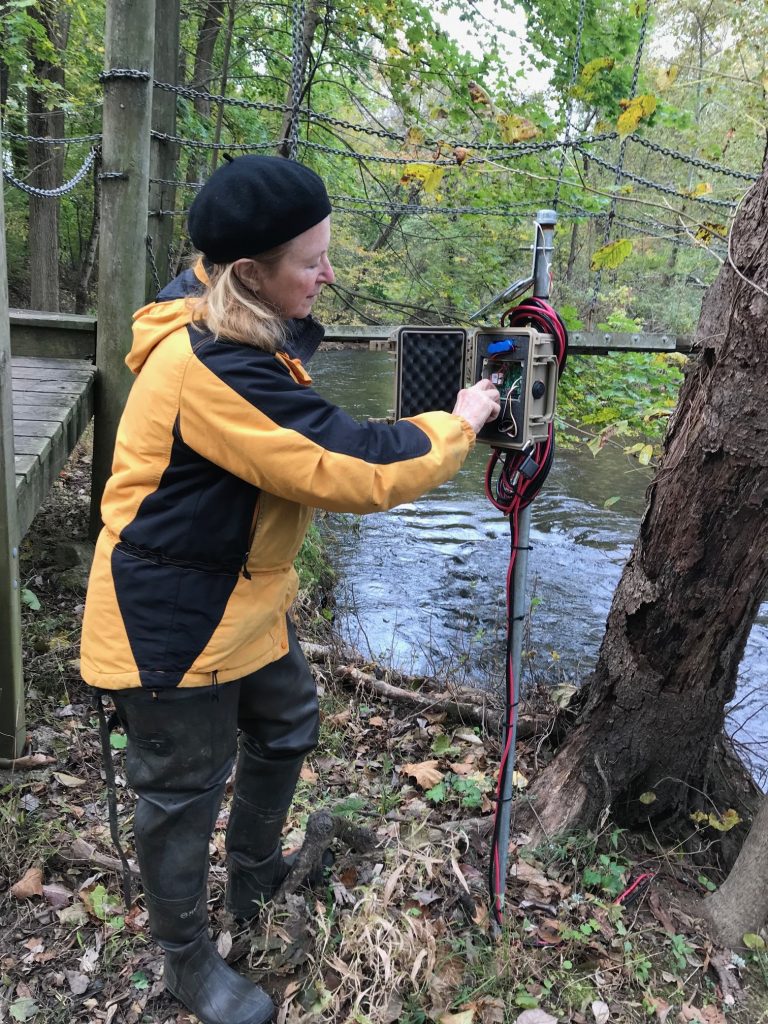
Research reveals value of volunteer-led water quality monitoring
| November 18, 2024
Community volunteers across the Delaware River Basin are collecting data that support local conservation goals, such as reducing the harmful impact of road salt and measuring how temperature spikes can affect aquatic life, new research reveals.
Further, volunteer-staffed community science projects help build a more detailed picture of human impacts on the Delaware River and its tributaries by focusing on smaller, more urban watersheds than those monitored by federal scientists.
The recently published research, by Stroud Water Research Center, analyzed data from EnviroDIY in the Delaware River Basin, a network of more than 150 stream monitoring stations maintained by more than 50 watershed organizations across the Delaware Watershed.
Volunteers are gathering reliable electric conductivity data (used to measure the impact of road salt) and temperature data (used to assess the ability of aquatic life to thrive), but generating reliable turbidity data is more difficult.
Turbidity sensors that measure haziness in water are themselves often clouded and such sensors require more maintenance to produce data reliable enough to illustrate how erosion and runoff can affect streams.
Stroud researchers also found that sensors that provide real-time water quality measurements generate such a volume of data that community science groups need additional support with data analysis.
“What we’ve been finding is that, with proper support from organizations like the Stroud Center, there’s absolutely no reason why citizen science data, community science data, can’t be used for the same purposes that professional science data are used for,” said David Bressler, Stroud’s community science facilitator.
Maintenance complicates turbidity monitoring
The Nature Conservancy’s Stream Stewards program created a specialized volunteer role in which “Sensor Scrubbers” frequently cleaned the Brandywine Creek sensors within the First State National Historical Park near Wilmington, Del.
Increased maintenance efforts weren’t enough to clear up data reliability issues, said Kim Hachadoorian, the stream stewards project manager.
“We just sort of take our turbidity data with a grain of salt,” Hachadoorian said, adding that sudden changes could simply be a result of sensor maintenance and not an indication that the water cleared up.
The Tookany/Tacony Frankford Watershed Partnership, which helps maintain a 30-square-mile suburban and urban watershed that covers portions of Philadelphia and lower Montgomery County, stopped turbidity monitoring when it shifted its focus from Jenkintown Creek to Shoemaker Run in 2021.
It became too difficult to find volunteers willing to travel out of the city every few days to clean the sensors, said Ryan Neuman, the partnership’s upstream conservation leader.
Conductivity and temperature data have proven easier to collect and more informative for local water quality goals, Neuman said.
The partnership has published fact sheets detailing spikes in winter-time salt levels and is also gathering long-term temperature data to assess the impact of streamside plantings on a local golf course.
Turbidity sensors use lasers that can generate false readings if blocked by debris, said Christa Reeves, water quality program manager for the Musconetcong Watershed Association.
The association plans to increase its current batch of 10 monitoring stations to 15 by next spring as it tracks water quality in a 42-mile watershed Reeves described as the largest contributor to the Delaware River from the New Jersey side.
New turbidity sensors with self-cleaning mechanisms require less maintenance but draw more power, creating additional stress on the monitoring stations’ solar panel and battery systems, Reeves added.
“Sensor technology for turbidity is a little rough,” Reeves said.
Science background isn’t necessary
Volunteer coordinators reported success with training programs, emphasizing that a background in science isn’t required to effectively gather water quality data.
“Anybody can do it if they commit to being trained,” Hachadoorian said. The majority of volunteers in the Nature Conservancy’s Stream Stewards program did not have any science background, she said, adding that the volunteer corps has benefited from the work of several retired scientists.
The Stream Stewards program conducts a series of orientation trainings that provide a holistic look at watershed ecology as well as in-the-field practice with monitoring equipment.
The program relies on 15 to 20 volunteers and aims to use their data to inform land management decisions within the 1,350-acre Brandywine Valley unit of the First State National Historical Park. Volunteers work with both the Nature Conservancy and the National Park Service.
At the Tookany/Tacony Frankford Watershed Partnership, only 20 to 25 percent of regular volunteers come in with a science background, Neuman said.
Most of the partnership’s volunteers are either high school or college students interested in being outside and doing scientific work or recent retirees using their expanded free time to focus on things they’re passionate about, Neuman said.
The Musconetcong Watershed Association has about 30 active volunteers at any given time and focuses on seasonal water quality concerns: algal blooms and temperature spikes in the summer, macroinvertebrate assessments in the spring and fall, and road salt levels in the winter.
The association has built partnerships with STEM programs, drawing on science, technology, engineering and math departments at Centenary University in Hackettstown, N.J., to find student volunteers and reaching out to local vocational technology programs to find high school students who want to complete projects using EnviroDIY data.
Some EnviroDIY volunteers decide to take on an expanded role overseeing sites run by multiple watershed organizations.
Charlie Coulter, a resident of Media Borough in Delaware County, Pa., has employed skills gained from a 35-year career as an industrial instrument technician to monitor 35 EnviroDIY sites for anomalies in their reported data.
“Each site has its own personality or fingerprint,” Coulter said. “They all look different.”
Carol Armstrong, who completed Master Watershed Steward training through the Penn State Extension, started volunteering with Stroud and worked her way up to monitoring 75 sites, analyzing online data to spot when sensor batteries might be low or turbidity levels seemed high enough to indicate a blocked sensor.
A cognitive neuroscientist and neuropsychologist, Armstrong worked for four years to improve salt pile management at the Phoenixville YMCA site about 5,000 feet upstream from the Pickering Creek Reservoir in Charlestown Township in Chester County, Pa. She’s also interested in monitoring macroplastics in rivers and the downstream impacts of landfills
“I did things that my curiosity led me to do,” Armstrong said.







